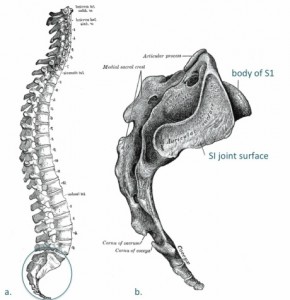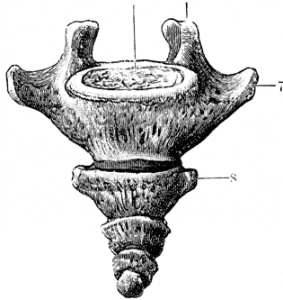There are 206 bones and 360 joints in an adult body (the number of joints can vary slightly). There are a number of bones in the body that are separate when we are born then solidify over time. The sacrum and the coccyx (tailbone) are examples of this.
At birth the sacrum is five bones that that become one sometime in our first two years as we come up to stand and walk. The tailbone, or coccyx, is three to five bones that calcify at the same time leaving a single joint between the sacrum and the tail.
This is the joint that articulates when you do a sucessful kegel or pelvic lift. When the levator ani—the big muscle of the pelvic floor— engages, it draws the coccyx slightly forward towards the pubic bone. I have written before how I hate the yoga instruction “take your tailbone towards your heel”. The coccyx moves forward not down. The key to a pelvic lift is that the action is deeply internal and the coccyx moves slightly forward but the sacrum and pelvis stay still. And when I say slightly I mean millimeters at best. But in the internal world of the body a millimeter can be like a mile.
Sometime between the age of 70 & 75 the joint between the sacrum and the coccyx fuses into one—this is part of the natural desiccation of ageing. As a result of this fusing, the resting tone of the levator ani at the moment the two bones become one, will determine the spatial relationship berween the coccyx and the pubic bone for the remainder of your life. This is one of the main reasons that I focus on building good tone in the pelvic floor.
In the evolutionary spectrum we are the first upright creatures and the change in the functional role of the pelvic floor is fairly radical. The organs of a quadruped sits on the belly suspended in a bag hanging from the spine. Additionally, the muscles of the pelvic floor are not very strong because a quadruped doesn’t need a stable pelvis to walk upright with its legs under the hips. Even the ape that walks a few upright feet at a time has to shift its body weight from leg to leg in order to walk upright for a few steps before it returns to its knuckles in the front.
The pelvic floor is also intimately related to our eliminative functioning. In fact the muscles of the pelvic floor need more resting tone than other muscles in the body. Otherwise we would be peeing all night as we sleep. And when I think about ageing, I think about incontinence. Having worked in a hospice I have seen firsthand what the ravages of ageing, weakness, and illness can do to our eliminative functions. Remaining continent is a prime goal of my adult life. Working to bring qualiy tone to the levator ani in the pelvic floor is one key to achieving this goal.
We have no control over if and when the joint between the sacrum and coccyx fuses but we do have control over what kind of resting tone the pelvic floor has when it happens.


